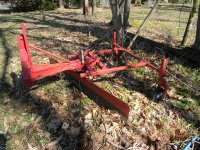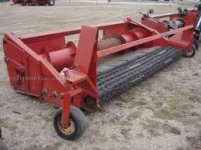2manyrocks
Super Member
- Joined
- Jul 28, 2007
- Messages
- 9,472
It doesn't quite work the way that I had hoped, at least not on a packed road or on the church parking lot, but it's not really a design fault as much as my own expectations, I guess.
On hard packed surfaces the wheels don't touch the ground if you want to cut much at all; instead the unit kind of "teeter-totters" with the blade being the fulcrum. If you lower the 3PH enough to put a lot of pressure (weight) on the blade then that lifts the wheels off the ground. If you then lower the wheels in this new position then the weight comes off the blade and it doesn't cut, it just changes the orientation of the cutting edge in relationship to the road.
In the church parking lot the kids have spun out enough to leave ruts in the center of the hard packed lot, but there is a lot of loose gravel around the periphery. The gauge wheels sink enough into the soft gravel to where you start moving a LOT of material, which is good in one way, but it leaves fairly big ridges on either side of the blade. It works, but it's pretty time consuming because eventually you have to end up with an even layer of gravel everywhere. Running the blade backwards (tractor still going forwards but the blade rotated 180) helps for the final passes.
Around buildings the wheels are a mixed blessing: it's usually already pretty flat so you don't have to do much and you can get it even flatter, but I was only able to pull material away from the buildings and that's not always what's needed. With the garage door open I could start partway inside the garage, but didn't want to hit the Lamborghini, so I could only go in so far without risking damage to my new blade, or incidentally to the Lambo.
On my gravel drive it only has a pretty thin top layer of salt and pepper round gravel, but isn't extremely flat. Here I did more damage than good as it would scalp the high spots and make the lows too deep and soft. We're talking a matter of an inch or two, not big ruts or noticeable hills and valleys. I suppose I could go ahead and flatten the whole drive and turnaround and then get a new top layer someday.
Let me preface this by saying I have a box blade and I have a rear blade with a different gauge wheel design. Your design is unique to my knowledge. At least, I can't think of one like it on TBN.
Regarding your first issue of evening out gravel in the church parking lot, I think this is just inherent to a rear blade. In my experience, a box blade is just more efficient at containing gravel and then getting it evenly spread.
Regarding your second issue of scalping high spots, my theory is that center mounted gauge wheels would be more likely to allow the blade to dig in on either side than wheels mounted on each side of the blade. And again, in my experience, a box blade is still easier to control and avoid scalping because the sides of the box act like runners compared to the relative knife edge effect of a rear blade.
Where the rear blade has its advantage is being able to tilt the blade to achieve a crown on a road or in moving snow off the road.
Even though I built rear gauge wheels for my rear blade after having seen it discussed on TBN, honestly, it sits and I use my box blade instead.


